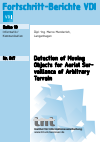Detection of Moving Objects for Aerial Surveillance of Arbitrary Terrain
Zusammenfassung
The detection of moving objects in aerial video sequences is a common application in safety and environmental monitoring. The challenge is the non-static camera, which is moving together with an aerial vehicle. To detect local changes due to movement of ground objects in such a scenario, the displacements of image pixels resulting from the motion of the camera need to be compensated. The most common method is to use a projective transformation and assume the observed scene to be planar. However, this is only valid for very high altitudes. It fails otherwise and results in falsely detected local motion. This work addresses the problem in two ways. After analyzing the error resulting from motion parallax, two detectors for moving objects in non-planar scenes are presented. One is based on a motion parallax model and one on a smooth optical flow approach. Following this, a motion compensation method for non-planar scenes is presented, allowing the use of image differences based methods ...
Schlagworte
- 10–33 2 Basic Principles 10–33
- 73–92 5 Experiments 73–92
- 97–106 Bibliography 97–106


